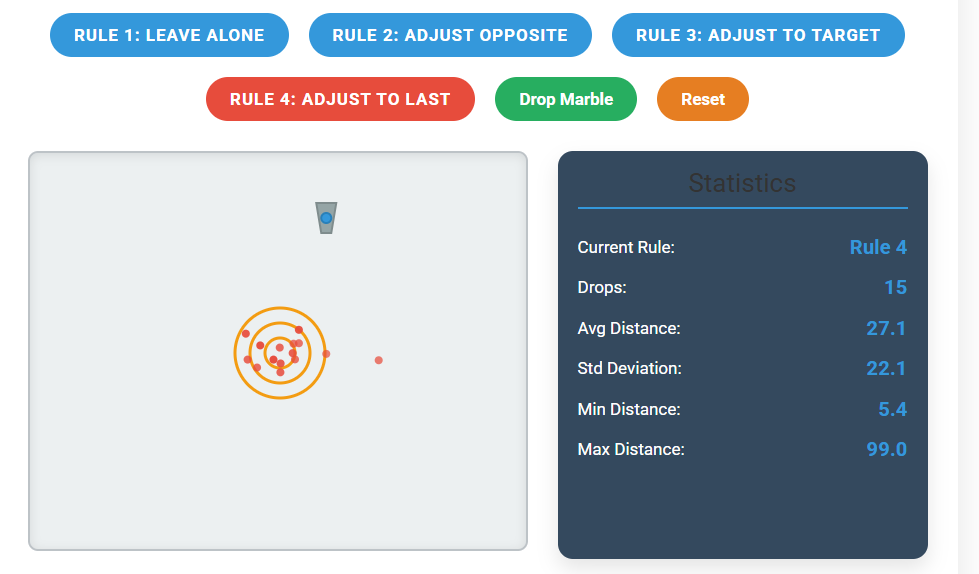Jump to the bottom of this post for a link to the experiment simulation.
Deming's Funnel Experiment is a demonstration designed to illustrate the adverse effects of making adjustments to a stable process without understanding the causes of variation. This is a practice especially common in managers who do not understand Systems of Human Performance. In the original experiment, marbles are dropped through a funnel onto a target on a sheet of paper. The goal is to get each marble as close to the target as possible.
The experiment demonstrates four different "rules" or management approaches for adjusting the funnel position based on where previous marbles landed:
Rule 1: Leave the funnel alone - No adjustments are made regardless of results
Rule 2: Adjust opposite to the last result - Move the funnel in the opposite direction by the amount of the last deviation
Rule 3: Move funnel over the target - After each marble, reposition the funnel directly over the target
Rule 4: Move funnel over the last marble - Position the funnel directly above where the previous marble landed
What the Experiment Teaches About Tampering
The Funnel Experiment reveals that Rule 1 (no adjustment) consistently produces the best results with the least variation around the target. The other three rules represent different forms of "tampering" - well-intentioned adjustments that actually make the process worse by increasing variation and moving results further from the desired target.
Key Lessons:
Natural Variation is Normal: Every stable process has inherent variation that cannot be eliminated through adjustments
Tampering Increases Variation: Making adjustments based on individual data points typically doubles, triples, or exponentially increases process variation
Good Intentions, Poor Results: Logical-seeming adjustments (like Rule 3's "aim for the target") often backfire
System vs. Special Causes: Adjustments should only be made when there are identifiable special causes, not for common cause variation
How the HTML Simulation Works
The interactive HTML simulation recreates the Funnel Experiment digitally, allowing users to experience the effects of different adjustment rules without physical materials.
Learning Experience:
Users can:
Observe Patterns: Watch how different rules create different scatter patterns
Compare Outcomes: Switch between rules to see immediate differences in performance
Understand Statistics: See numerical proof of which approaches work better
Experience Insights: Discover counterintuitive truths about process management
The simulation makes Deming's abstract concepts tangible and provides immediate feedback on the consequences of different management philosophies. Users typically discover that their intuitive responses (Rules 2-4) perform worse than simply leaving the process alone (Rule 1), providing a powerful lesson about the dangers of tampering with stable processes.
This hands-on experience helps managers and quality professionals understand when to act and when to resist the urge to "fix" processes that are actually performing normally within their natural variation limits.
Real-World Applications:
The experiment directly relates to common management mistakes such as:
Adjusting production processes after every quality measurement
Changing budgets based on monthly variances from previous periods
Modifying organizational policies after each employee survey
Setting quotas based on recent output rather than system capability
Making personnel changes in response to normal performance variation
Simulation Link
Follow this link to play the Red Bead Experiment Simulation: https://Sixsigma-consulting.com/Funnel-Experiment


